helping children ages 12–18 who are at risk of residential placement or hospitalization. This highly individualized program integrates face-to-face, virtual, and technologyenhanced services to meet the daily needs of each client at home and in their community, ensuring comprehensive and compassionate care tailored to every child and family. PROGRAM HIGHLIGHTS Service Area & Availability Program Timeline & Structure Technology & Family Support Child ACTT serves youth and families in Alamance, Burke, Catawba, Durham, Gaston, Mecklenburg, Orange, and Wake counties. The care team is available 24/7 throughout treatment, providing consistent support for both urgent and ongoing needs. The program runs for about six months, aiming to stabilize the home and prevent residential placement or hospitalization. A multidisciplinary team, including a psychiatric nurse practitioner, nurse, therapist, behavior specialist, respite provider, and others, visits families multiple times a week. Services are flexible and tailored to each family’s changing needs. Families in Child ACTT receive smartphones to support telehealth, mood tracking, treatment apps, and secure communication with the care team. Usage is monitored for safety. The program also connects families to vital resources like food, housing, utilities, and clothing to support overall well-being. To submit a referral, scan the QR code or use the website or email below: ChildrensHopeAlliance.org/referral ACTTPrgrmAssts@childrenshopealliance.org Supports include: u 24/7 crisis response u Evidence-based therapy u Data-informed planning u Professional parenting u Respite care u Medication management u Wellness coaching u Therapy u Care coordination u Safety planning
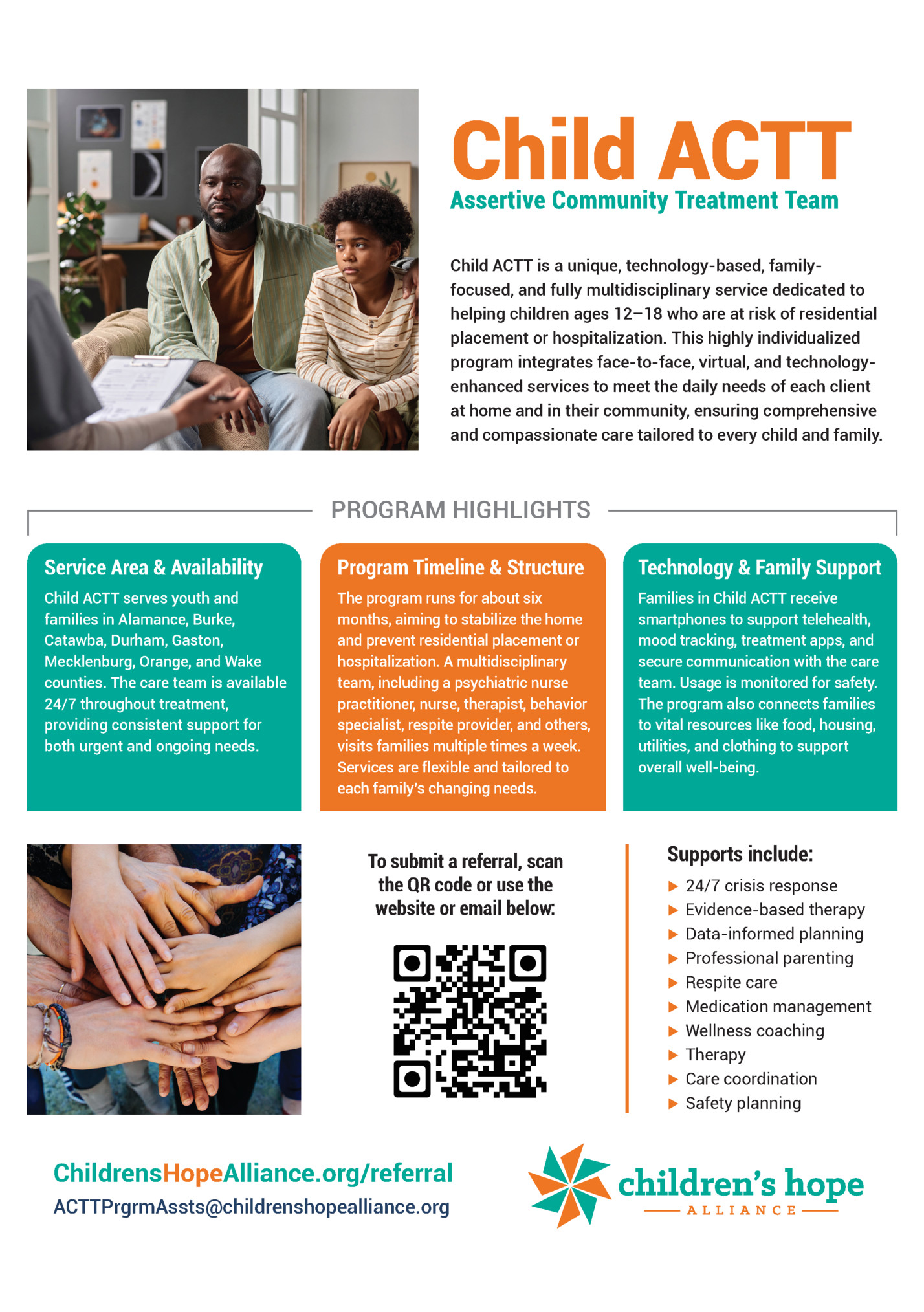
At 13, Isabella was referred to Child ACTT after multiple hospitalizations for self-harming behaviors and suicidal thoughts. Her anger was intense, especially at home with her siblings. Although she had a few friends at school, she often felt alone and struggled to trust others. Her family also had a strong hesitation about medication, which made it difficult to fully address the emotional and behavioral symptoms Isabella was experiencing. When therapy began, her therapist focused on building trust and creating a safe space. Isabella was guarded at first. She said she was using coping skills but continued to struggle quietly. A month in, she admitted to her therapist, “I selfharmed and I didn’t want to tell you because I thought you would be disappointed in me.” That moment marked a turning point. Isabella began reaching out directly to her therapist when she was having a hard time, showing that trust was growing between them. Together, she and her therapist created a grounding box filled with her favorite things. Teddy bears brought her comfort, and a reward system using Hello Kitty helped her stay motivated. Her family became more open to the use of medication for Isabella, and the change was clear. Her outbursts became less frequent, she laughed more with her family, and the suicidal thoughts faded. Though she did not like being praised, near the end of treatment she said, “That’s the old me. I don’t know who that is anymore.” To celebrate her progress, she was given a six foot teddy bear. It was a symbol of comfort and how far she had come. She also built a stronger relationship with her school principal and found the courage to speak up about bullying. Isabella was discharged after nine months of therapy. Her family later shared that she was still doing well and thanked the therapist for helping them see a new side of their daughter. Today, Isabella wants to live. She sees a purpose in her life. She dreams of becoming a veterinarian. Therapy helped her understand her worth and gave her the tools to manage her emotions. She still enjoys drawing, listening to music, and spending time with her guinea pigs. ChildrensHopeAlliance.org
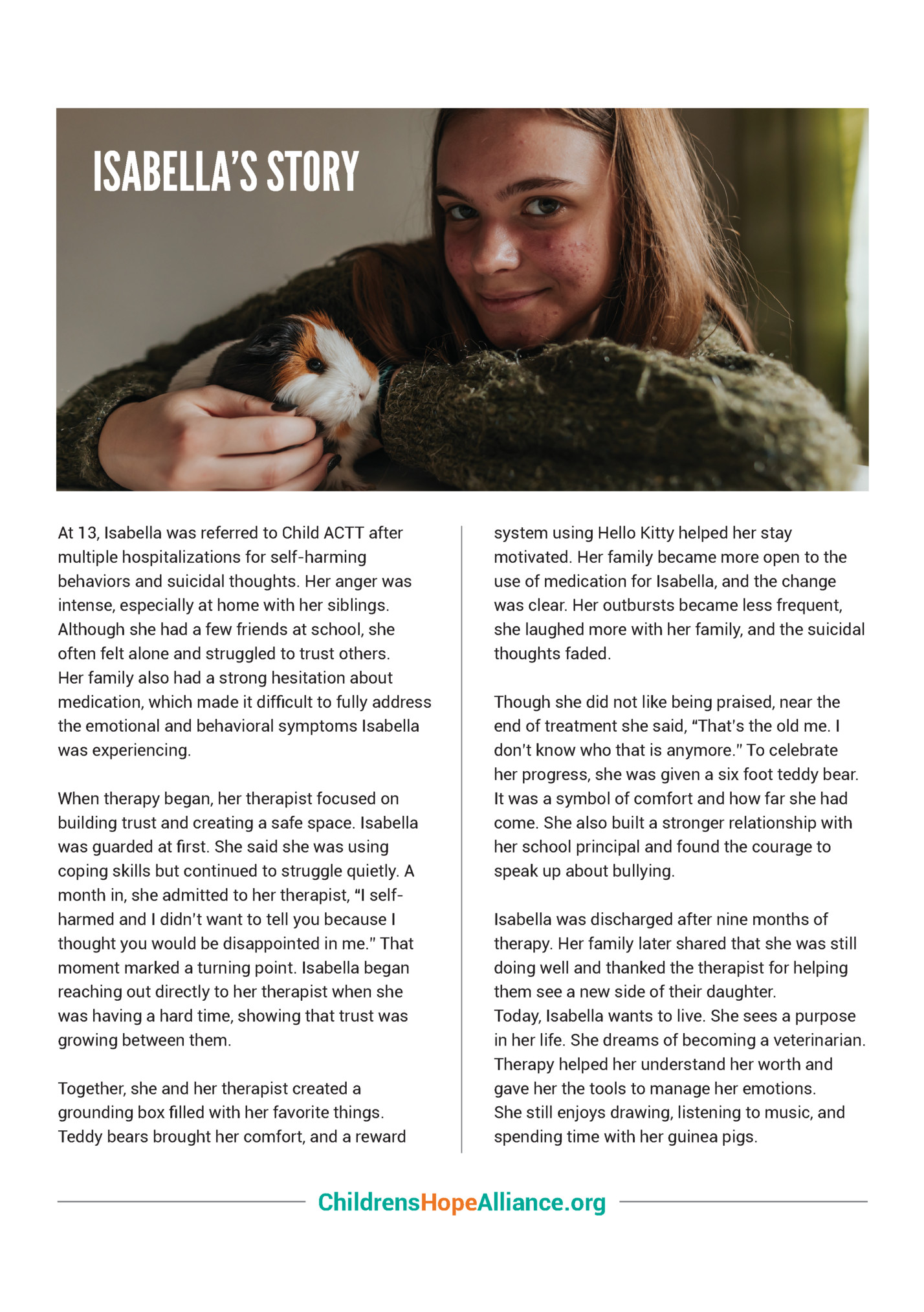
helping children ages 12–18 who are at risk of residential placement or hospitalization. This highly individualized program integrates face-to-face, virtual, and technologyenhanced services to meet the daily needs of each client at home and in their community, ensuring comprehensive and compassionate care tailored to every child and family. PROGRAM HIGHLIGHTS Service Area & Availability Program Timeline & Structure Technology & Family Support Child ACTT serves youth and families in Alamance, Burke, Catawba, Durham, Gaston, Mecklenburg, Orange, and Wake counties. The care team is available 24/7 throughout treatment, providing consistent support for both urgent and ongoing needs. The program runs for about six months, aiming to stabilize the home and prevent residential placement or hospitalization. A multidisciplinary team, including a psychiatric nurse practitioner, nurse, therapist, behavior specialist, respite provider, and others, visits families multiple times a week. Services are flexible and tailored to each family’s changing needs. Families in Child ACTT receive smartphones to support telehealth, mood tracking, treatment apps, and secure communication with the care team. Usage is monitored for safety. The program also connects families to vital resources like food, housing, utilities, and clothing to support overall well-being. To submit a referral, scan the QR code or use the website or email below: ChildrensHopeAlliance.org/referral ACTTPrgrmAssts@childrenshopealliance.org Supports include: u 24/7 crisis response u Evidence-based therapy u Data-informed planning u Professional parenting u Respite care u Medication management u Wellness coaching u Therapy u Care coordination u Safety planning
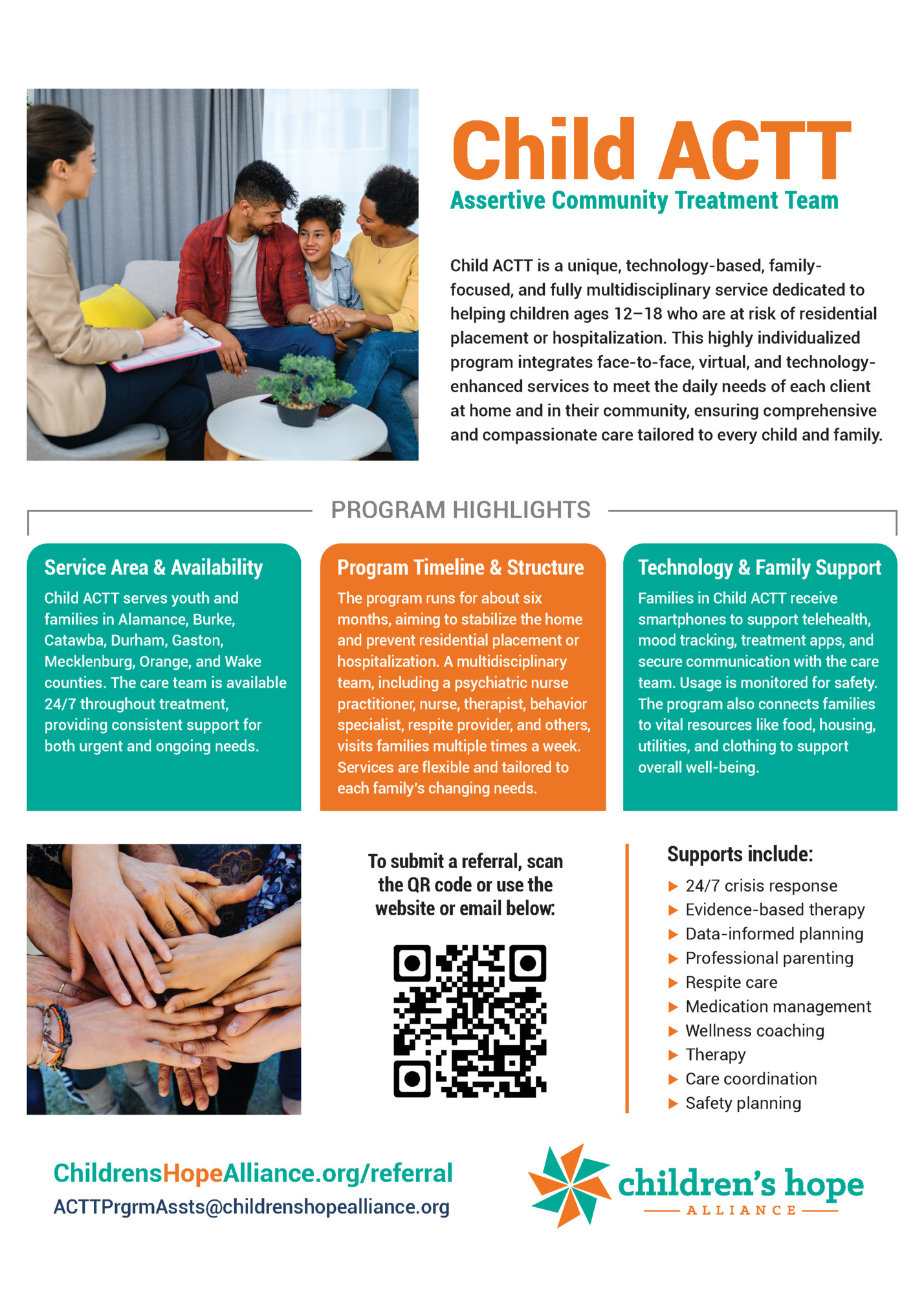
At 13, Isabella was referred to Child ACTT after multiple hospitalizations for self-harming behaviors and suicidal thoughts. Her anger was intense, especially at home with her siblings. Although she had a few friends at school, she often felt alone and struggled to trust others. Her family also had a strong hesitation about medication, which made it difficult to fully address the emotional and behavioral symptoms Isabella was experiencing. When therapy began, her therapist focused on building trust and creating a safe space. Isabella was guarded at first. She said she was using coping skills but continued to struggle quietly. A month in, she admitted to her therapist, “I selfharmed and I didn’t want to tell you because I thought you would be disappointed in me.” That moment marked a turning point. Isabella began reaching out directly to her therapist when she was having a hard time, showing that trust was growing between them. Together, she and her therapist created a grounding box filled with her favorite things. Teddy bears brought her comfort, and a reward system using Hello Kitty helped her stay motivated. Her family became more open to the use of medication for Isabella, and the change was clear. Her outbursts became less frequent, she laughed more with her family, and the suicidal thoughts faded. Though she did not like being praised, near the end of treatment she said, “That’s the old me. I don’t know who that is anymore.” To celebrate her progress, she was given a six foot teddy bear. It was a symbol of comfort and how far she had come. She also built a stronger relationship with her school principal and found the courage to speak up about bullying. Isabella was discharged after nine months of therapy. Her family later shared that she was still doing well and thanked the therapist for helping them see a new side of their daughter. Today, Isabella wants to live. She sees a purpose in her life. She dreams of becoming a veterinarian. Therapy helped her understand her worth and gave her the tools to manage her emotions. She still enjoys drawing, listening to music, and spending time with her guinea pigs. ChildrensHopeAlliance.org
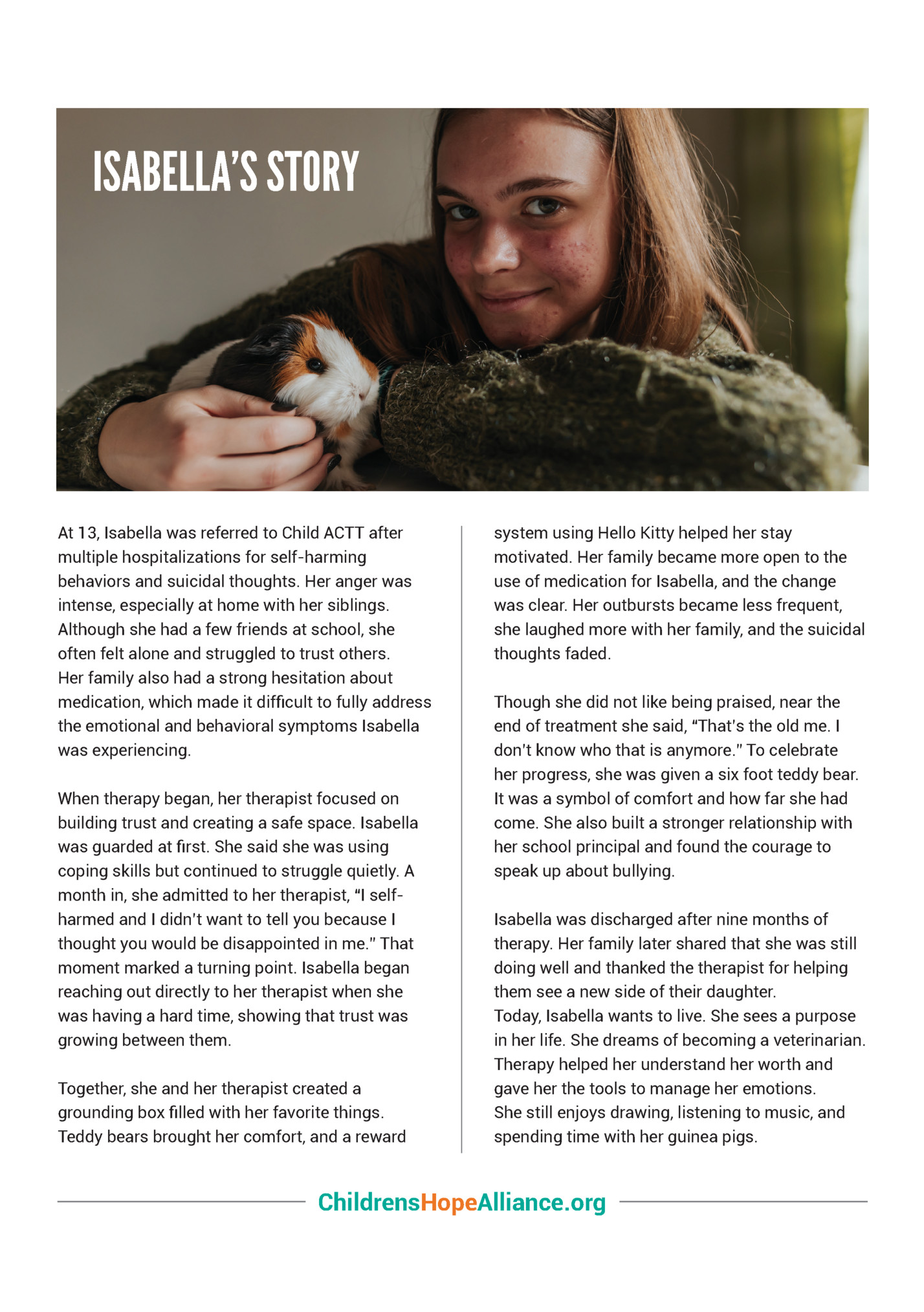
Child ACTT Child-Focused Assertive Community Treatment Team A unique science and technology-based, family-focused, complete multidisciplinary service with the mission of healing hurting children in their own homes and communities. Services include: u Psychiatry & Medication Management u Health & Wellness Coaching u Individual & Family Therapy u Care Coordination u Crisis Management u Enhanced Safety Planning Services currently available to children ages 12-18 who are at risk of residential placement or hospitalization.
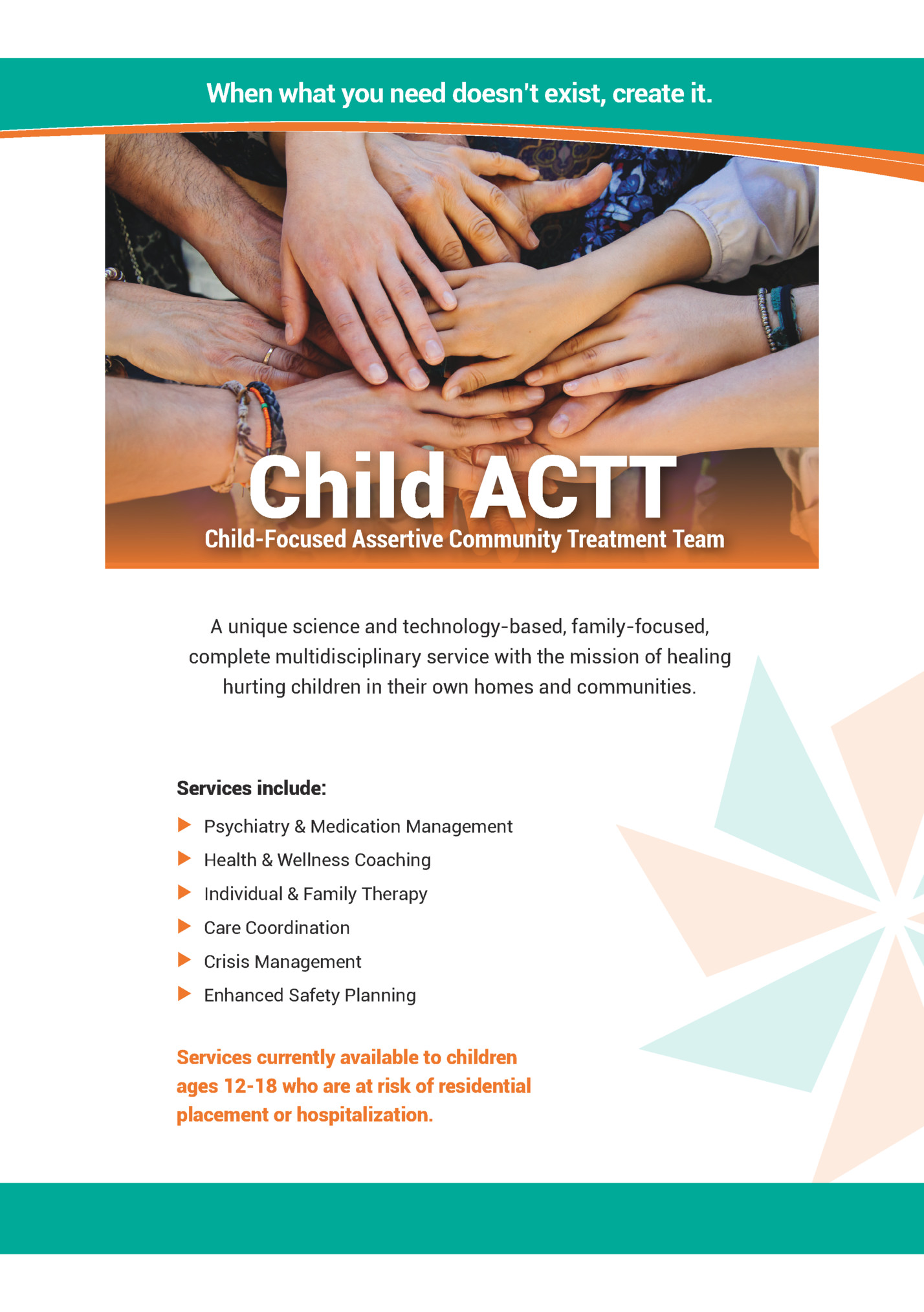
that the team cannot provide, the team will coordinate with an outside therapist possessing that skill to contract and assist the team as available. What safety measures can Child ACTT provide for their clients in need of high-level services? What services does the Child ACTT Team provide? u Psychiatric Evaluation and Medication Management, Individual and Family Therapy, Health and Wellness Education, Nursing Evaluations, Planned Respite, Parent Skills Coaching, Care Coordination, and Crisis Response Services. Some children may qualify for ACTT Professional Foster Parenting options as available. How often does the Child ACT Team make contact? u Child ACTT is a highly individualized service that offers a combination of face-to-face, virtual, and technology integrated services to meet the daily needs of our clients. Child and identified caregivers participate in daily mood check-ins with our Lifetiles APP, and have the ability to contact ACTT Staff 24/7 for support through our APP, or on our Crisis Line. Therapy occurs multiple times a week in-person and virtually depending on the family’s needs and preferences, and our medical professional staff, including a full-time registered nurse and psychiatric provider, offer holistic integrated care by which the client receives nutritional planning, exercise coaching, health and wellness treatment, and medication management. Our behavior specialist works with parents on managing crisis via enhanced community-based safety planning and intensive teaching which is vital when caretakers are supporting dysregulated youth. Through an interdisciplinary community-based approach, the ACTT service is able to provide equivalent alteratives to locked psychiatric residential services that keep families working together towards hope, health, and healing for generations. What evidence-based practice does Child ACTT use? u Child ACTT is able to pick from multiple different evidencebased models when working with a child and family, based on the clients needs. All Child ACTT clinical staff are trained in the Teaching Family Model, Cognitive Behavioral Therapy, and Motivational Interviewing, and Trauma Informed Care. However, many providers on the team are specialized in TFCBT, EMDR, DBT, and have Substance Abuse credentials as well. If there is a particular treatment that a child/family needs, u Child ACTT begins planning for safety at the very beginning of services, by reviewing each referral and clinical documentation for potential safety needs. Child ACTT then creates an initial individualized safety plan and comprehensive crisis plan with the child and family. These plans encompass what safety should look like in the home, the school, the community, with peers or other children, online, with technology, etc. The individual safety plans are updated monthly or after any critical incident. Child ACTT often employs “outside the box” safety measures if needed (providing security or door/window alarms to families, lock boxes for medications or sharps, specific measures to address runaway behavior or self-injury). While Child ACTT cannot be in the home environment 24/7, the parent/guardian become the first line of supervision for children in the service, and the parent/guardian have access to the Child ACT Team 24/7 for safety coaching and support as needed. We believe that our enhanced safety planning promotes the appropriate shared responsibility for caretakers and their communities. Our goal is to generalize the practice of keeping children safe in their natural environment. It is a goal that is impossible to achieve when youth receive equivalent services in a locked residential facility. What if the parent/guardian does not want the child to return home or feels it is unsafe for them to return? u While many of the parents/guardians are excited about their child returning to or staying in the home setting, occasionally we meet parents who are very nervous about their child returning home from the hospital or other residential settings. Often, these families have been through multiple failed placements or services. They are often tired, and sometimes are afraid that they will not be able to manage their child’s special needs. The Child ACT team begins to engage the parent/guardian early in the referral process, by contacting them and fully explaining what the service can do to support them. While ultimately the parents have to agree to the service, Child ACTT is often able to meet families where they are at, and incorporate increased family therapy and other supports when needed to caregivers so they have the tools they need to unite or remain together successfully. We lean into this fear and make it a critical component of service delivery. This often includes increasing the intensity of services in the beginning, and ensuring that planned respite is scheduled so that caretakers can be gradually exposed to caring for their child who is dealing with mental illness. Often, other wrap around services are utilized, to ensure the parents/caregivers have adequate breaks and supports needed, even after Child ACTT services have ended (B3 respite, IDD services, etc.).
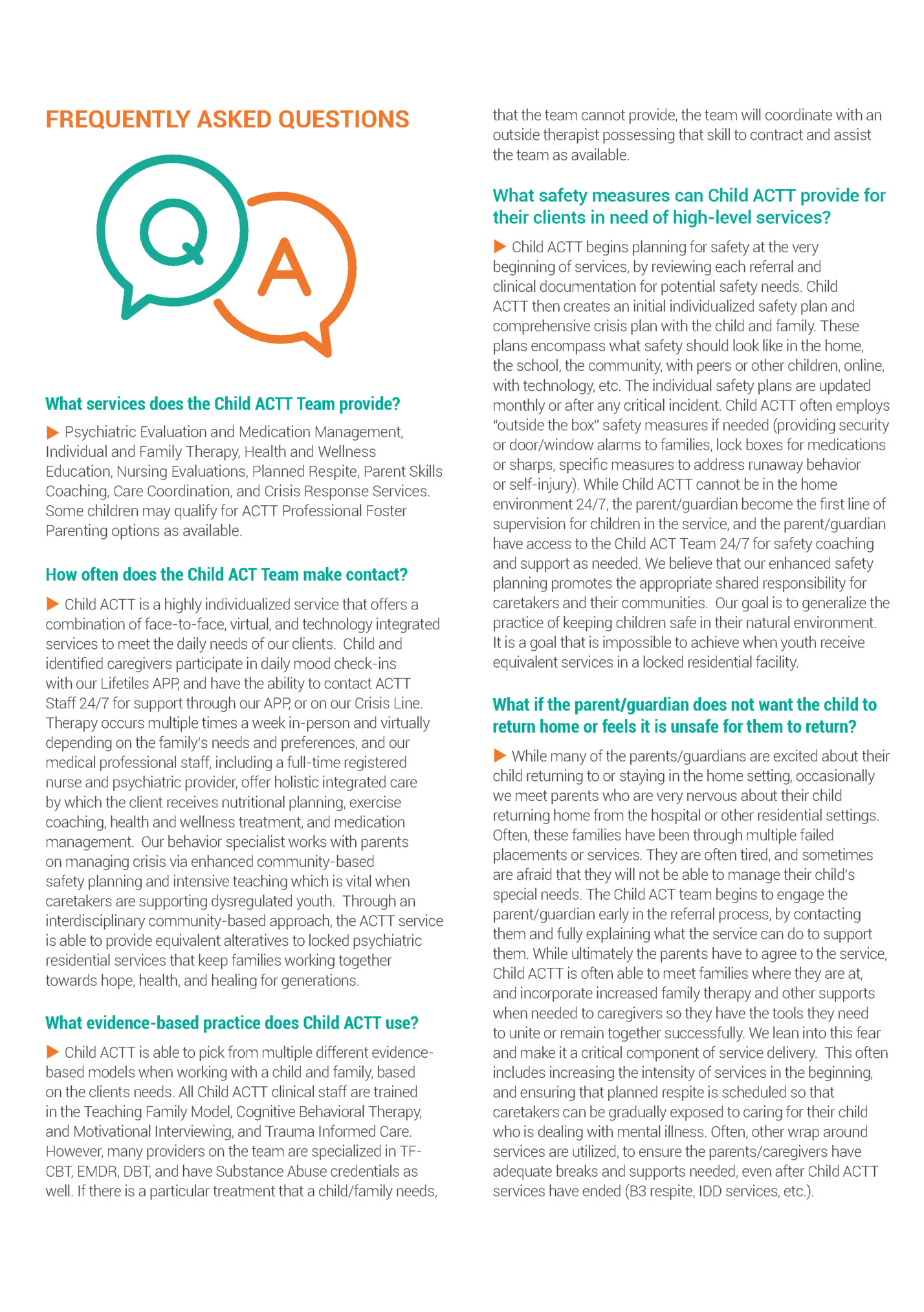
u The ideal child ACTT client is a child who is currently being considered for out of home placement, especially children being considered for PRTF. Our service is designed to prevent highend residential care and our goal is to keep families together despite facing many challenges that come with complex needs. Are there any children excluded from Child ACTT services? u All children admitted to the Child ACTT service must meet medical criteria as outlined in our Service Definition. They must have qualifying insurance or be willing to pay out of pocket for the service. Children must be between the ages of 12-18 years old. They must have a mental health diagnosis. Children diagnosed with Substance Abuse Disorders, Intellectual disabilities, or Autism Spectrum Disorder will be considered on a case-by-case basis. Ultimately, the Child ACTT Referral team will staff all incoming referrals to ensure the Child ACT Team can adequately meet the needs of the child/family. How does Child ACTT incorporate families’ Social Determinant of Health Needs? u Child ACTT is unique from other services in that it provides robust assessment and Care Coordination based on identified Social Determinant of Health needs. Child ACTT can coordinate with families and local helping organizations to assist with housing, food, education, utility, medical, and vocational needs. How does Child ACTT use data to inform team processes and treatment decisions? u Child ACTT uses data collected in the Wellness Check TOP multi-rater assessment monthly as well as the CHA Lifetiles App daily to routinely assess the client’s and caregiver’s symptoms, risks and needs. This data is reviewed an analyzed by trained professionals to inform and enhance treatment decision making and planning. The Child ACT Team participates in daily and weekly clinical staffing to incorporate this data and adjust treatment efficiently. How do I make a referral? How long does it take to get authorized? u You can make a referral by contacting Children’s Hope Alliance at 1-800-320-4157. The only thing needed to make a referral is a referral form and a clinical assessment. If the child does not have a clinical home, the clinical assessment can be completed by the Child ACT Team. The length of time that it takes to begin ACTT services depends on where the child is currently, and if they are safe. Children in safe environments generally take longer to get authorized due to insurance rules regarding authorization timeframes. Children who have no services, or who are actively unsafe, may be able to be authorized faster and qualify for expedited authorization. The responsiveness of the child’s parent/guardian and clinical home also play a factor in the amount of time it takes to gain authorization. The child may or may not be denied by insurance as well. Is Child ACTT considered a lower level than PRTF or Residential Care? u Child ACTT is actually considered the same level of service as PRTF. The major difference between the two services is that one is provided in an unlocked home setting (ACTT), and one is provided in a locked facility. In Child ACTT, the parent/ guardian and school staff supervise the child 24/7, whereas in a PRTF, the supervision is done by paid staff. Child ACTT provides many of the same services (or more) than a PRTF unit. Children often get more individual and family therapy, community care coordination, and more family health and wellness needs met when using a community-based service. When in a residential service, it is difficult to address family dynamics and family needs, and to truly change the home environment. Many times, even if a child shows progress in a residential setting, their behavior and patterns will go back to old ways once put back in the same unchanged home environment. FFC, TFC, IAFT, Residential Group Homes Level 1-III, IIH, MST, and FCT are all step downs from the Child ACTT Service. What happens if the child or family does not respond to ACTT treatment? u If a child or family does not do well in Child ACTT Services, Child ACTT can help coordinate other services that may best fit the child and family. On rare occasion, a child may be recommended for a short-term crisis stabilization unit, or acute hospital stay while in ACTT Services. Once the acute crisis has resolved, the child may return home with ACTT Services. If the child is recommended for a locked PRTF service, Child ACTT will assist with placement efforts. However, a locked PRTF will only be recommended if the child is an active danger to self or others, and a locked building is required. Child ACTT believes in trying to assist the child and family in remaining together, and in the benefits of being treated in the community vs. pursing residential treatment. Research shows that long term residential treatment has poor outcomes and has risks associated with it that can be avoided with proper community based treatment and support. Child ACTT Child-Focused Assertive Community Treatment Team
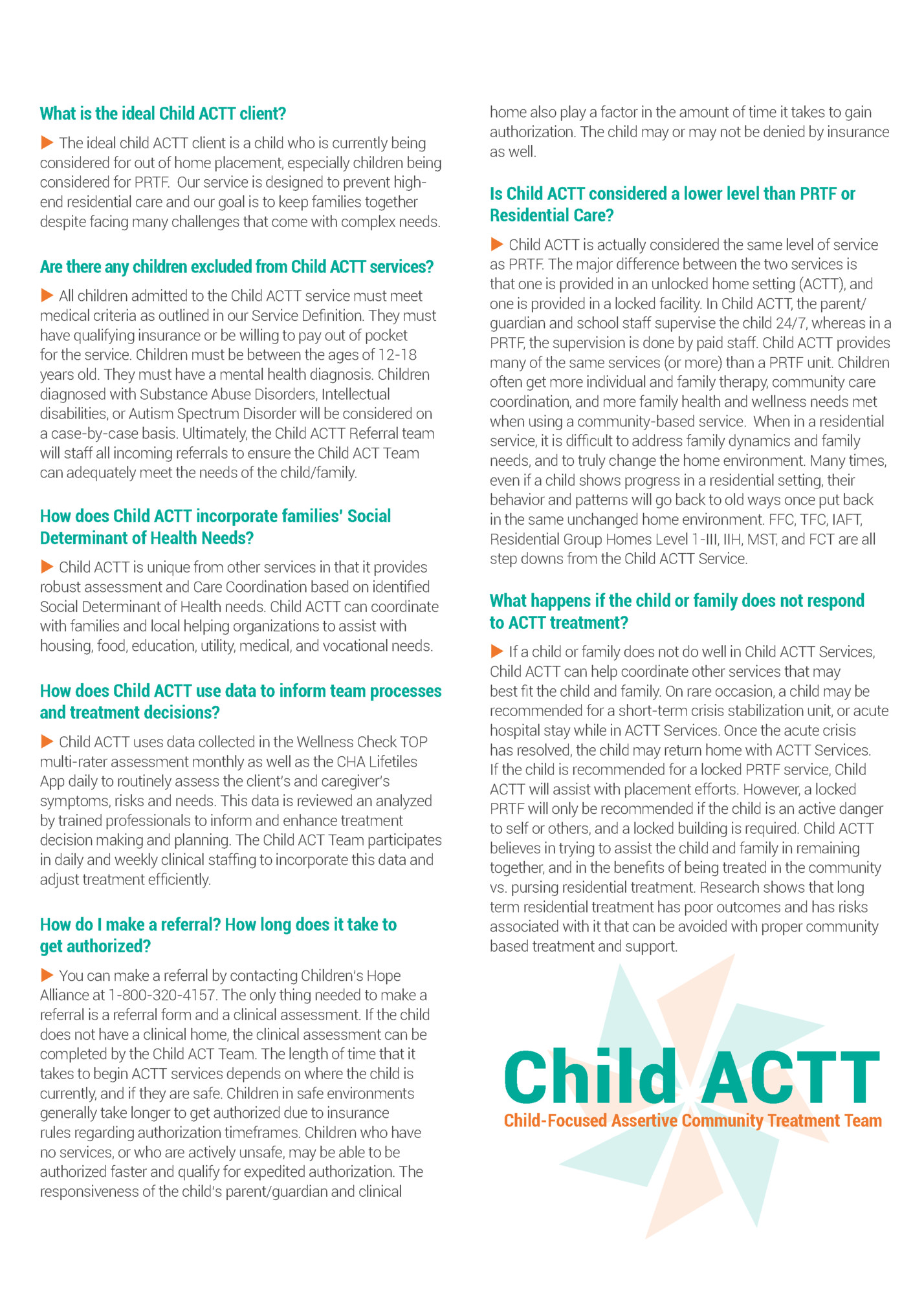
• Smart phones provided if needed to enhance treatment engagement with the treatment team and to teach 24/7 skills through the CHA App • Children’s Hope Alliance custom app used to deliver secure text messaging, video conference, and education • Data-driven treatment planning and assessment through partnership with Outcome Referrals & TOP Assessment tool • Professional Parenting option for children who need a safe place to live while learning new skills • Scheduled in-home and in-community respite available For more information, call 800-320-4157. www.ChildrensHopeAlliance.org
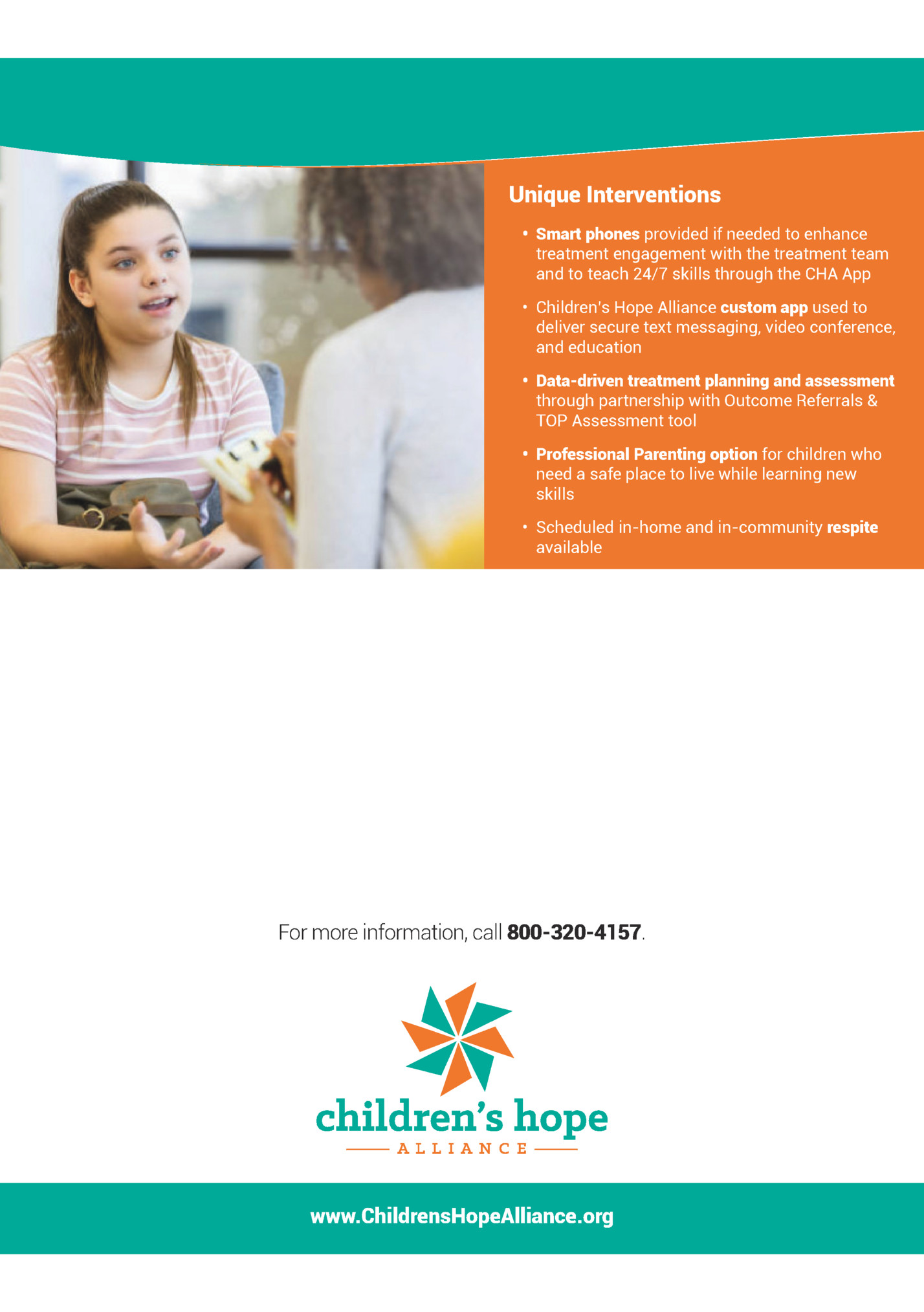
Program Child-Focused Assertive Community Treatment Team Program Before considering residential placement, reach out today to learn about how this community-based service can quickly support youth and families in crisis.
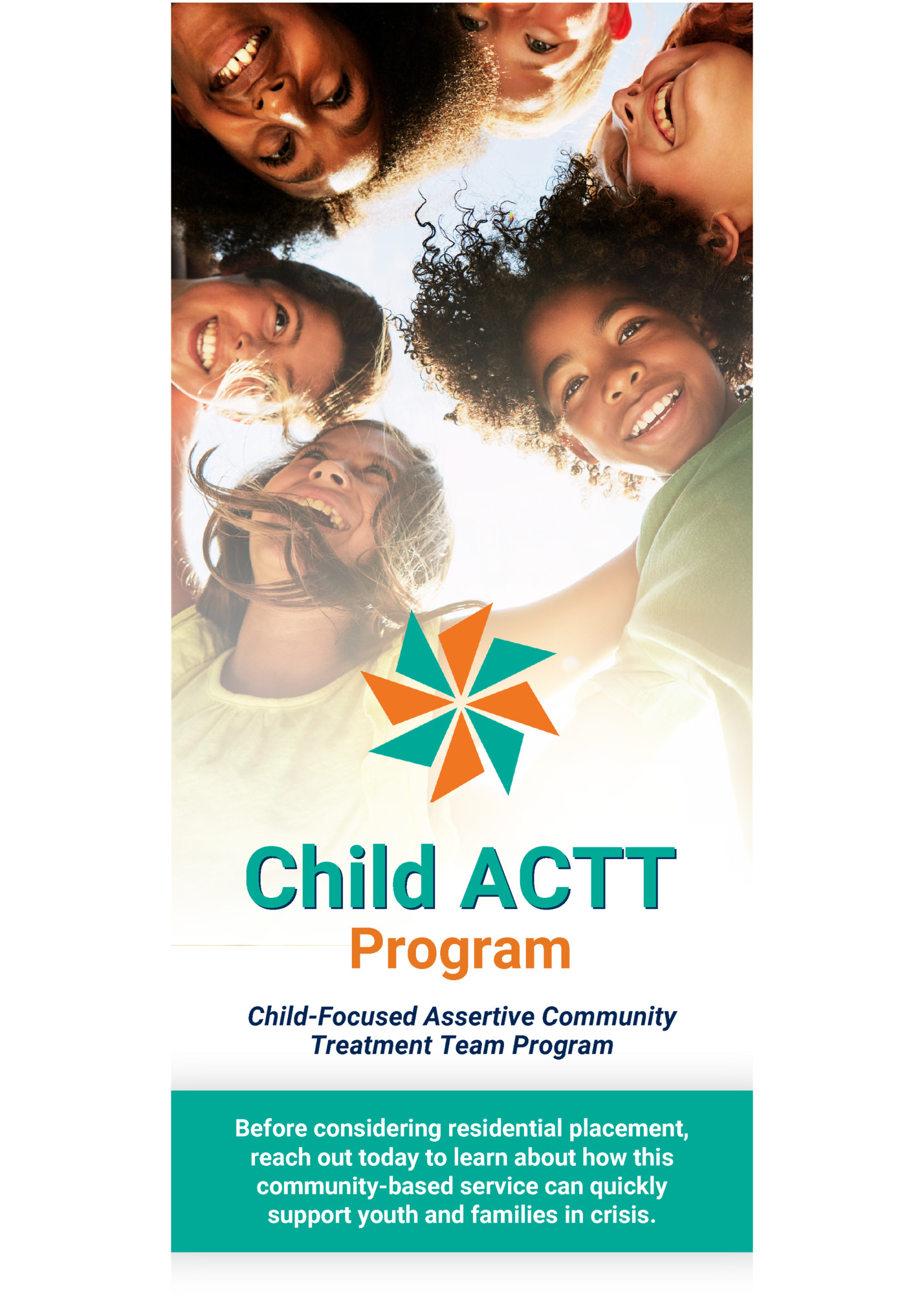
Fleepit Digital © 2021